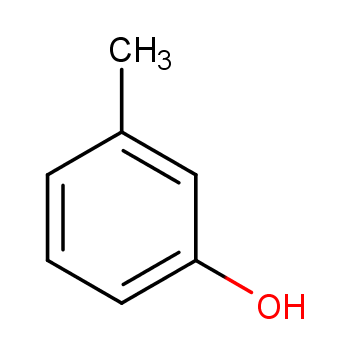 |
 |
1-Hydroxy-3-methylbenzene 1-Hydroxy-3-methylbenzene,3-Hydroxytoluene,3-Methylphenol 3-cresol 3-Hydroxytoluene 3-MeC6 H4OH 3-methyl-phenol EINECS 203-577-9 FEMA 3530 Gallex hydroxy-3-methylbenzene M-CRESOL 70 M-CRESOL F & D VERSION m-Cresole META-CRESOL MFCD00002302 m-kresol m-Me-C6H4-OH m-methylphenol m-methyl-PhOH m-oxytoluene m-toluol Phenol, 3-methyl- Phenol,3-methyl QR C1
Hazard Codes:? T
T
Risk Statements: 24/25-34-39/23/24/25-23/24/25?
R24: Toxic in contact with skin?
R25: Toxic if swallowed?
R34: Causes burns?
R39: Danger of very serious irreversible effects
R23/24/25: Toxic by inhalation, in contact with skin and if swallowed
Safety Statements: 36/37/39-45-36/37?
S36/37/39: Wear suitable protective clothing, gloves and eye/face protection?
S45: In case of accident or if you feel unwell, seek medical advice immediately (show the label whenever possible)?
S36/37: Wear suitable protective clothing and gloves
RIDADR: UN 2076 6.1/PG 2
WGK Germany: 1
RTECS: GO6125000
F: 8
HazardClass: 6.1
PackingGroup: II
HS Code: 29071200
Hazardous Substances Data: 108-39-4(Hazardous Substances Data)
The D-Cyclohexylalaninol with its cas register number is 205445-49-4. It also can be called as D-Cyclohexylalaninol and the Systematic name about this chemical is (2R)-2-(cyclohexylamino)propan-1-ol. It belongs to the Peptide.
Physical properties about D-Cyclohexylalaninol are: (1)ACD/LogP: 1.44; (2)ACD/LogD (pH 5.5): -1.65; (3)ACD/LogD (pH 7.4): -1.27; (4)ACD/BCF (pH 5.5): 1; (5)ACD/BCF (pH 7.4): 1; (6)ACD/KOC (pH 5.5): 1; (7)ACD/KOC (pH 7.4): 1; (8)#H bond acceptors: 2; (9)#H bond donors: 2; (10)#Freely Rotating Bonds: 4; (11)Polar Surface Area: 12.47Å2; (12)Index of Refraction: 1.478; (13)Molar Refractivity: 46.81 cm3; (14)Molar Volume: 165.3 cm3; (15)Polarizability: 18.5510-24cm3; (16)Surface Tension: 34.9 dyne/cm; (17)Enthalpy of Vaporization: 59.65 kJ/mol; (18)Vapour Pressure: 0.000641 mmHg at 25°C
You can still convert the following datas into molecular structure:
(1)SMILES: OC[C@H](NC1CCCCC1)C
(2)InChI: InChI=1/C9H19NO/c1-8(7-11)10-9-5-3-2-4-6-9/h8-11H,2-7H2,1H3/t8-/m1/s1
(3)InChIKey: XPWWRSIBXKFKTA-MRVPVSSYBN
(4)Std. InChI: InChI=1S/C9H19NO/c1-8(7-11)10-9-5-3-2-4-6-9/h8-11H,2-7H2,1H3/t8-/m1/s1
(5)Std. InChIKey: XPWWRSIBXKFKTA-MRVPVSSYSA-N
Acute toxicity - Oral, Category 3
Acute toxicity - Dermal, Category 3
Skin corrosion, Category 1B
| Pictogram(s) |   |
|---|---|
| Signal word | Danger |
| Hazard statement(s) | H301 Toxic if swallowed H311 Toxic in contact with skin H314 Causes severe skin burns and eye damage |
| Precautionary statement(s) | |
| Prevention | P264 Wash ... thoroughly after handling. P270 Do not eat, drink or smoke when using this product. P280 Wear protective gloves/protective clothing/eye protection/face protection. P260 Do not breathe dust/fume/gas/mist/vapours/spray. |
| Response | P301+P310 IF SWALLOWED: Immediately call a POISON CENTER/doctor/\u2026 P321 Specific treatment (see ... on this label). P330 Rinse mouth. P302+P352 IF ON SKIN: Wash with plenty of water/... P312 Call a POISON CENTER/doctor/\u2026if you feel unwell. P361+P364 Take off immediately all contaminated clothing and wash it before reuse. P301+P330+P331 IF SWALLOWED: Rinse mouth. Do NOT induce vomiting. P303+P361+P353 IF ON SKIN (or hair): Take off immediately all contaminated clothing. Rinse skin with water [or shower]. P363 Wash contaminated clothing before reuse. P304+P340 IF INHALED: Remove person to fresh air and keep comfortable for breathing. P310 Immediately call a POISON CENTER/doctor/\u2026 P305+P351+P338 IF IN EYES: Rinse cautiously with water for several minutes. Remove contact lenses, if present and easy to do. Continue rinsing. |
| Storage | P405 Store locked up. |
| Disposal | P501 Dispose of contents/container to ... |
none
 |
Literatures:
Pandey, Paras N.; Purkayastha, Makhan L. Synthesis, 1982 , # 10 p. 876 - 878  Yield: ~90% |
 |
 |
Literatures:
US2766294 , ; Journal of the American Chemical Society, , vol. 83, p. 2507,2509  Yield: ~% |
m-Cresol is an important organic intermediate (building block) to synthetize substituted aryl products.